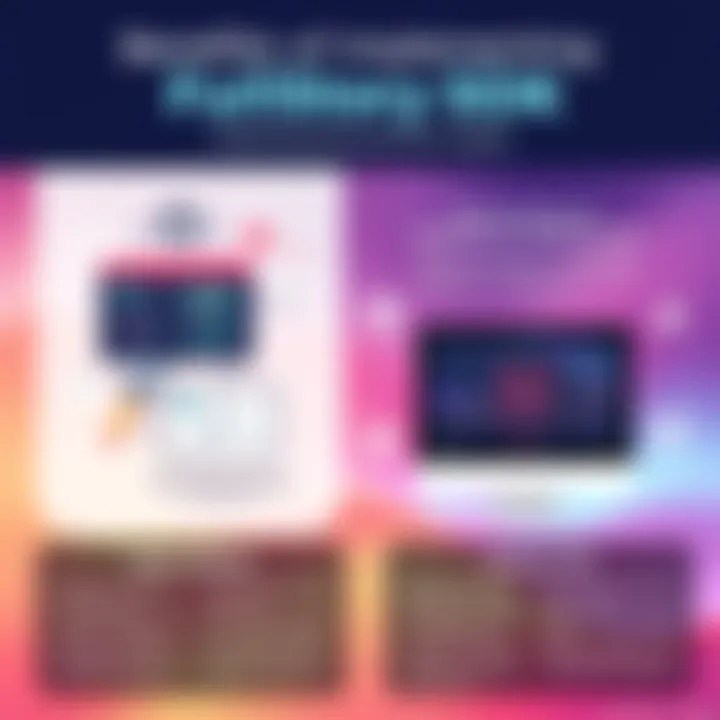Mastering FullStory SDK for Enhanced User Insights


Software Overview
In an era where digital interactions define user engagement, tools that can provide deep insights into user experiences are invaluable. The FullStory SDK stands as a robust solution in this landscape, designed specifically for developers and businesses looking to refine their applications based on real user data. This SDK enhances the ability to track, measure, and analyze user behavior effectively.
Brief Description of Software
The FullStory SDK offers a seamless way to capture user interactions on a website or application. By integrating this software into your platform, you can gain access to a wealth of data on how users navigate, what they click on, and where they encounter issues. Essentially, it translates complex user behaviors into actionable insights, empowering teams to make data-driven changes.
Key Features and Functionalities
- Session Replay: Capture a user's entire journey, allowing you to see exactly what they experience.
- Event Tracking: Monitor specific interactions such as clicks, forms, and navigation flows.
- Heatmaps: Visual representations of user interactions that help identify popular areas of engagement.
- Advanced Search & Filtering: Easily find specific sessions based on user actions or demographics, making troubleshooting efficient.
- Integrations: Works well with various other tools such as Customer Relationship Management and project management software—bridging gaps and enhancing workflows.
These features together create a comprehensive toolkit for developers and businesses striving for excellence in user experience. With FullStory SDK, understanding how users interact with your platform head-on is no longer a guessing game.
Detailed Comparison
When evaluating FullStory SDK, it's important to compare it against other market offerings to understand its unique advantages.
Comparison with Competitors
Many analytics tools claim to optimize user experiences, but few provide as in-depth a view as FullStory. Competitors often focus on metrics like page views or bounce rates, offering numbers without the context behind them. In contrast, FullStory provides qualitative insights alongside quantitative data, making its value proposition stronger.
That said, tools like Hotjar and Crazy Egg do offer some overlapping functionalities, such as heatmaps and simple session recordings, yet they may lack the comprehensive analysis features that let you dive deeper into the user's path.
Pricing Structure
FullStory operates on a subscription model with varying tiers based on usage and features. Usually, pricing aligns with session recordings and data retention periods, accommodating businesses of different sizes.
- Starter Plan: Ideal for smaller businesses with limited traffic, offering essential features to get started.
- Growth Plan: Designed for medium-sized companies, adding advanced functionalities for deeper analysis.
- Enterprise Plan: Tailored for large enterprises needing extensive support, high data limits, and customization options.
When contemplating the right solution, it’s crucial to analyze how many users you'll be monitoring and the specific insights you aim to attain.
Understanding your budget in conjunction with your goals is key to optimizing your experience with FullStory SDK.
In summary, the FullStory SDK is designed to equip businesses with invaluable insights into user behavior, allowing for continuous improvement of digital interactions. By utilizing robust features that bring nuance to data analysis, companies can enhance user satisfaction and, ultimately, their bottom line.
Understanding FullStory SDK
In the increasing complexity of digital interactions, organizations must equip themselves with reliable tools that deliver actionable insights into user behavior. This is where FullStory SDK comes into the picture. Understanding this SDK is paramount for those looking to enhance their application or website's user experience. At its core, FullStory SDK aids in capturing user interactions, thereby providing vital data that can inform business decisions and improve overall engagement.
What is FullStory SDK?
FullStory SDK is a powerful toolkit that provides detailed analytics about how users engage with your digital platform. Designed for developers and product managers, it records user sessions with precision, allowing you to visualize every click, scroll, and interaction. Think of it as a crystal ball into user behavior, enabling companies to diagnose issues in real-time. Unlike traditional analytics, FullStory goes beyond numbers by connecting the dots through actual user sessions—every mouse movement, every input field filled.
By employing FullStory SDK, businesses can turn data into narratives. This is key; after all, it’s not just about what users do but why they do it. For instance, if a user abandons a shopping cart, FullStory can show the exact series of actions leading up to that decision. This insight fosters a deeper understanding of user experience, as companies can identify friction points in the journey.
Key Features of FullStory SDK
FullStory SDK is packed with a host of features designed to optimize user experience effectively:
- Session Replay: Watch unfiltered, real-time playback of user sessions, allowing you to see your product through users’ eyes.
- Event Tracking: Automatically capture significant events, such as clicks and form submissions, without extensive coding.
- Error Tracking: Identify and resolve errors swiftly by monitoring how they affect user interactions and frustrations.
- Performance Metrics: Gather insightful data on performance, roaming from page load times to server response rates.
These features collectively allow businesses to create a user-centric digital environment, enhancing productivity and ultimately revenue.
How FullStory SDK Works
At its heart, FullStory SDK integrates effortlessly into your existing tech stack via a simple JavaScript snippet. Once implemented, it begins unobtrusively gathering data, including session recordings and user interactions. This data is then processed and made accessible through an intuitive dashboard.


The workings of FullStory can be summed up in a few essential steps:
- Integration: Add the SDK to your website or application with minimal effort, ensuring you have full visibility of user actions.
- Data Capture: The SDK captures interactions, creating an event log that includes timestamps, mouse movements, and clicks.
- Analysis: Utilize the dashboard to analyze collected data. Searching through user behavior has never been simpler, allowing for tailored insights.
- Optimization: Act upon insights gleaned, making data-driven decisions that target user experience improvements.
This process ultimately enables teams to iterate on designs quickly, eliminating guesswork and enhancing the overall user journey.
The Significance of User Experience Analytics
In today's fast-paced digital landscape, understanding user behavior has become a cornerstone of effective business strategy. User Experience (UX) analytics plays a pivotal role in illuminating the paths that users tread as they interact with web applications and platforms. By leveraging tools like FullStory SDK, businesses can gather critical insights that inform design decisions, refine interactions, and ultimately enhance the overall user experience.
Importance of User Experience (UX)
User Experience is essentially the sum of interactions that people have with a product or service. If users are navigating a website or app, their satisfaction hinges on how seamlessly they can achieve their goals. Positive UX leads to increased customer loyalty, higher conversion rates, and better retention.
For instance, a client in the hospitality sector faced a 30% drop in bookings after a site redesign. Upon examining their UX analytics, they discovered several obstacles in the booking process. Adjustments were made, based on user feedback, significantly improving the navigation flow.
- Key Elements of Effective UX:
- Usability: How intuitive is the interface?
- Accessibility: Can all users, regardless of ability, access the website?
- Aesthetics: Does the visual design appeal to the target audience?
Ultimately, embracing UX is not just about making things look pretty or work smoothly. It’s about cultivating a relationship between the user and the product, one that can lead to fruitful outcomes.
Role of Analytics in Optimizing UX
Analytics serves as the lens through which we can examine and comprehend user interactions. It transforms complex user data into actionable insights. Without it, businesses might as well be flying blind. For example, a popular e-commerce site employed FullStory’s analytics tool to track user behavior during the checkout process. They found that users were frequently abandoning their carts at the payment stage, which led to an urgent review of the payment interface. This analytical approach not only resolved the immediate issue but also reduced cart abandonment by 20% within weeks.
- Key Benefits of Using Analytics for UX Optimization:
- Identifying Pain Points: Recognize where users struggle or drop off.
- Informed Design Decisions: Data-driven insights lead to more effective design choices.
- User-Centric Adjustments: Tailoring experiences based on evidence supports better outcomes.
By continually monitoring and analyzing user data, businesses not only enhance performance but can also quickly pivot strategies in response to evolving user needs.
Finally, continual investment in user experience analytics reflects a company's commitment to its users. This focus fosters sustained engagement and loyalty, ultimately driving long-term success. Without this commitment, businesses risk drifting away from the very people who fuel their endeavors.
Implementation Strategies for FullStory SDK
When it comes to enhancing user experiences, the implementation of the FullStory SDK is a pivotal step for any organization. Without the right integration strategy, even the most powerful tools can fall flat. Any business that aims to leverage user insights effectively must approach the FullStory SDK with a well-thought-out plan. This section will discuss the critical components of the integration process, the challenges that may arise, and best practices to ensure successful usage of this tool.
Step-by-Step Integration Process
- Initial Setup: The first step involves acquiring the FullStory SDK. This can be done through the FullStory website, where you can sign up for an account. Follow the prompts to retrieve your unique FullStory project key.
- Incorporation into Your Application: Once you have your project key, it's time to integrate the SDK into your application. This generally requires adding a snippet of JavaScript to your app's codebase. For example, in a React app, you might place the FullStory script into your main index file:jsx
script>
window['_fs_debug'] = false;
window['_fs_host'] = 'fullstory.com';
window['_fs_org'] = 'YOUR_ORG_ID>';
window['_fs_namespace'] = 'FS';
(function(m,n,e,t,l,o,g,y)
if (e in m)
if (m.console && m.console.log)
m.console.log('FullStory namespace conflict. Please set window['_fs_namespace'].');
return;
o.q=[];y=n.createElement(t);y.async=1;
y.src='https://cdn.fullstory.com/SCRIPT_ID.js';
l=n.getElementsByTagName(t)[0];l.parentNode.insertBefore(y,l);
script> - Configuration of Settings: After the SDK has been added, you're encouraged to configure FullStory settings tailored to your needs. This can involve setting up custom events, session recordings, and variable tracking. Each organization has its unique needs, so consult your product team's objectives while tailoring these settings.
- Testing Implementation: Prior to going live, it’s essential to test the integration. Use tools like Chrome Developer Tools to ensure data is being captured accurately. This step is critical to identify any issues before they can impact real users.
- Launch and Monitor: Once you’re confident that all systems are a go, launch your application! Post-launch, continuously monitor the engagement metrics through FullStory’s dashboard to make sure everything is working as expected.
Common Challenges in Integration
Implementing the FullStory SDK might sound straightforward, but assure yourself it can come with its own set of hurdles. Here are a few common challenges that teams might face:
- Compatibility Issues: Sometimes, existing frameworks may conflict with the FullStory SDK, resulting in unexpected behavior. It's crucial to know the environments where you're integrating.
- Data Privacy Concerns: Organizations must adhere to data privacy laws, such as GDPR. Proper masking of sensitive data or employing policies around user consent can require extra effort during implementation.
- Overwhelming Amount of Data: While FullStory captures extensive user data, sorting through vast amounts can become a chore. It’s important to have a strategy for filtering and prioritizing this data to avoid information overload.
Best Practices for Effective Use
Once the FullStory SDK is integrated, the focus shifts to maximizing its utility. Here are some best practices to keep in mind:
- Define Clear Objectives: Start with clear goals for what you wish to accomplish using FullStory. This might include reducing bounce rates or enhancing user pathways.
- Regularly Review Recordings and Reports: Schedule periodic reviews of the data generated by the SDK. Understanding the movement and clicks of users can lead to actionable insights.
- Training for Team Members: Ensure that your team members are well-versed with FullStory’s features. This training facilitates better use of the tool and encourages proactive analysis.
- Utilize Feedback Loops: Engage with your development team to create feedback loops based on FullStory findings. Integrating insights into the product development cycle is key to continuous improvement.
By adhering to these strategies, the FullStory SDK can effectively enhance user experience and provide valuable insights that drive decision-making.
Expanding on these strategies ensures not just successful implementation, but also ongoing lifecycle management of the FullStory SDK. In the rapidly evolving digital space, staying agile and informed will serve organizations well.


Benefits of Using FullStory SDK
Utilizing the FullStory SDK provides an array of advantages that are hard to overlook for businesses seeking to enhance their digital platforms. This SDK goes beyond simple metrics, giving a deeper understanding of user interactions which can lead to innovative strategies. Here, we delve into three main benefits: enhancing user insights, improving decision-making, and facilitating agile development.
Enhanced User Insights
FullStory SDK allows organizations to gather rich, qualitative data about user behavior. Rather than relying solely on surface-level metrics such as bounce rates or page views, FullStory captures session recordings, enabling teams to view exactly how users navigate through applications.
Such detailed insights are invaluable. For instance, a travel booking site using FullStory can identify drop-off points in their funnel. Perhaps users are abandoning their carts after the payment section. By playing back the session, the team might discover that the form looks too complicated or that users are confused by unclear messages. This isn’t just data; it’s the story behind user decisions.
The ability to pinpoint specific pain points aids in understanding user frustrations or delights. This clarity isn’t just useful for one-off tweaks; it allows for ongoing, iterative improvement in user experience by continually targeting areas needing adjustment.
"Data is a tool for clarity, and FullStory is a lens to enhance that clarity."
Improved Decision-Making
When decisions are based on clear data, outcomes tend to be more favorable. FullStory SDK arms teams with the information they need to make informed choices. The actionable insights gained from user sessions lead to more precise, data-driven strategies.
For example, an e-commerce platform might need to decide whether to simplify a checkout process or introduce new features. Instead of relying on gut feelings, they can analyze user interactions with both processes, weighing user feedback directly tied to each option.
With FullStory, feedback loops are short; teams can test changes and observe immediate results. This leads to a culture where decisions are continuously informed by user data rather than assumptions. This agility is crucial in a competitive landscape, as every second counts.
Facilitating Agile Development
The agile methodology, focused on iterative development and quick responses to change, aligns seamlessly with the capabilities offered by the FullStory SDK. With its continuous cycle of collecting data, analyzing it, and applying insights, product teams can integrate user feedback right into their development sprints.
For example, a SaaS provider could launch a new feature and gather immediate feedback through FullStory’s insights on usage patterns and user experiences. If the feedback indicates that users struggle to navigate the feature, the team can quickly pivot to address these issues in the next sprint.
This ability to adapt promptly fosters a responsive product development cycle, ensuring that user satisfaction remains high while the product evolves based on real-world use.
In summary, the benefits of using FullStory SDK extend from enhanced understanding of user behavior to informed decision-making and support for agile development. This positions businesses not only to react better to user needs but also to anticipate them, ultimately leading to stronger products and more satisfied users.
Real-World Applications of FullStory SDK
Understanding how the FullStory SDK operates in real-world scenarios is essential. This tool has proven to be invaluable across various industries, with its applications ranging from e-commerce to educational platforms. By utilizing this SDK, businesses can gather actionable data so they can make informed decisions that resonate well with their target audiences.
One of the most vital aspects of implementing FullStory SDK is the ability to analyze user interactions in a comprehensible way. With this tool, organizations can view how customers engage with their websites or apps, identifying both successes and pain points. It’s about seeing what works and what doesn’t, making adjustments where necessary.
"Understanding user behavior is not just about counting clicks; it's about knowing the story behind those clicks."
Case Studies of Successful Implementation
In examining practical examples, we can look at how different companies have harnessed the FullStory SDK effectively. For instance, a leading online retail platform integrated FullStory and made significant marketing strides. By observing the customer journey, they noticed that many users abandoned their carts at checkout. With this insight, they revamped the checkout process, simplifying it and reducing friction. The result? A 30% increase in completed transactions within just a few months.
Another success story comes from a major financial services company. They utilized FullStory SDK to enhance customer onboarding. By analyzing where users dropped off during registration, they made crucial updates to their interface. This led to a 40% increase in completed account sign-ups. Their data-driven adjustments proved that understanding user interactions can lead to significant improvements in both usability and conversion rates.
Industry-Specific Use Cases
Different sectors can tailor FullStory’s capabilities to meet their unique requirements.
- E-commerce: Businesses can track scroll depth and click rates on product pages. If a product's visibility isn’t as high as expected, companies can adjust display options or provide better images.
- Healthcare: Patient portals can improve user experience by analyzing the flow of information. If users struggle to find necessary resources, health providers can reorganize their online systems accordingly.
- Education: Educational institutions can see which resources students engage with most. This can lead to enhanced curriculum design that aligns with student interests and behaviors.
While the core functionalities remain the same, the application of FullStory SDK's insights can differ drastically, showing its versatility in enhancing user experiences across numerous fields.
Utilizing data analytics like those provided by FullStory can become a game changer for any business focusing on user-centered design. The right adjustments, informed by comprehensive insights, can lead businesses to not just meet, but exceed their users' expectations.
Comparative Analysis with Other SDKs


In the rapidly evolving realm of digital tools, an analysis comparing FullStory SDK with other software development kits (SDKs) is not just insightful, but essential. This examination highlights how FullStory stacks up against competitors, diving into their unique offerings, strengths, and shortcomings. As decision-makers and IT professionals sift through various options, understanding these distinctions can lead to better strategic choices that align with users' needs and organizational goals.
Comparison of Features
When evaluating any SDK, notably features, first impressions can be deceiving. FullStory SDK stands out due to its comprehensive tools designed to monitor user activity in detail. Here’s a quick rundown to illustrate some critical feature comparisons:
- Session Replay: FullStory provides a seamless session replay feature that captures user interactions exactly as they occur. In contrast, competitors like Hotjar offer a more rudimentary version of this, lacking the same depth of insights.
- Heatmaps: While FullStory's heatmap feature offers elegant visuals to comprehend user engagement better, other SDKs, such as Crazy Egg, offer somewhat similar features but may not integrate as completely with session replay functions.
- Error Tracking: FullStory not only tracks user behavior but also captures errors that occur during their sessions. This dual capability is something that isn’t as robust in SDKs like Pendo, which tend to focus primarily on feedback collection without such detailed interaction logging.
The importance of these features cannot be overstated. They directly affect how effectively an organization can interpret user behavior and thereby enhance the user experience. A deeper understanding of these comparisons not only boosts the efficacy of decision-making but also equips teams with the insights necessary for enhancing product design.
Evaluating Pricing Models
No analysis of SDKs is complete without addressing the often-contentious topic of pricing models. FullStory typically employs a tiered pricing strategy that scales according to the size and needs of the business. This allows small startups to enter with a basic plan that expands as they grow.
Some key points regarding pricing models include:
- Tiered Plans: FullStory’s structure offers distinct tiers that correlate with additional features and user capacity. In contrast, tools like Mixpanel might present a flat-rate fee that could become prohibitive as the user base grows.
- Value for Money: When comparing similar offerings, FullStory tends to justify its pricing through the rich data analytics package it provides. Businesses may find that while the upfront cost seems higher than alternatives, the return on investment from insights gained may be significantly greater.
- Trial Options: FullStory's free trial allows organizations to assess the service upfront, while some competitors may not provide the same flexibility, pushing potential users into long-term commitments without comprehensive testing.
Navigating these pricing intricacies can be a real minefield. Particularly for entrepreneurs and decision-makers, understanding not only the cost implications but also the value derived from each SDK is pivotal in making an informed choice.
"An informed decision is the best decision. Understanding SDK offerings allows for a strategic alignment with business goals."
In summary, the comparative analysis of FullStory SDK against other options reveals critical insights that can guide professionals in their quest to optimize user experience. By addressing features and pricing models, businesses can confidently select the right tools that meet their specific needs.
Future Trends in User Experience SDKs
The world of user experience (UX) is constantly evolving, pushed along by rapid technological advancements. As developers and businesses strive to enhance user satisfaction, understanding the future trends in User Experience SDKs becomes essential. The adoption of innovative tools like FullStory SDK hinges upon the notion that staying ahead means adopting new methodologies that improve insight and engagement. So, let's explore what's on the horizon.
Emerging Technologies
User Experience SDKs like FullStory blend seamlessly with up-and-coming technologies, shaping how we understand and analyze user interactions. Some notable trends include:
- Artificial Intelligence: AI can automate data analysis, making it easier for businesses to extract insights. Imagine machine learning algorithms that can predict user behavior based on past interactions. Companies embracing AI tools will have the upper hand.
- Augmented Reality (AR): AR has begun influencing UX design by allowing users to interact with digital information in a real-world context. It transforms user interactions, creating immersive experiences that could lead to improved engagement through SDKs.
- Voice Recognition: With tools like Amazon Alexa and Google Assistant, voice interfaces are gaining traction. SDKs that can integrate voice recognition technology will likely offer personalized user experiences, pushing the boundaries of standard interfaces.
Incorporating these technologies will not only enhance user engagement but also allow companies to remain competitive and relevant.
Predictions for SDK Evolution
As we gaze into the crystal ball of SDK development, several predictions stand out:
- Greater Customization: Users are demanding experiences tailored specifically to their needs. Future SDKs will likely offer more customizable features, allowing developers to implement unique solutions tailored to their user demographics.
- Seamless Integration: The trend will shift towards SDKs that can easily integrate with other tools and applications. This will create an ecosystem where data flows freely, allowing a more holistic view of user interactions across platforms.
- Focus on Data Privacy: As data concerns grow, SDKs will evolve to prioritize user privacy. Businesses must adopt compliance measures while still gathering actionable insights.
- Real-Time Analysis: More SDKs will incorporate real-time analytics capabilities, helping businesses act quickly on user feedback and behavior patterns. If a problem arises, being able to respond in real time can make all the difference in user retention.
"In the end, the customer experience is the king; staying ahead in user experience means adapting quickly to the changing landscape."
In summary, keeping an eye on these trends and predictions will give decision-makers the foresight needed to adapt and thrive in the competitive digital landscape. As the technology unfolds, it's crucial not just to keep pace with these advancements but to understand how they can be leveraged for optimum user engagement.
By understanding these future trends, businesses can significantly enhance their strategies to not only connect with users but also foster loyalty by meeting and exceeding their expectations.
Epilogue
As we reach the end of this comprehensive guide, it’s crucial to reflect on the significant implications of adopting the FullStory SDK for businesses focused on enhancing their user experience. First and foremost, the impact of accurate user analytics cannot be overstated. In today’s dynamic digital landscape, understanding how users interact with your platform is like having a compass in uncharted waters. The insights yielded by FullStory’s sophisticated analytics empower businesses to tailor their offerings, ultimately leading to an increase in customer satisfaction and retention.
Summarizing the FullStory SDK Impact
With FullStory SDK, organizations can transform raw data into meaningful strategies. The platform tracks essential user interactions, which can identify friction points or opportunities for improvement. What sets FullStory apart is its capability to replay user sessions, allowing teams to see firsthand the journey users take. This unique feature provides actionable data that can directly inform design changes, improve navigation, and streamline user interfaces.
"Data is not just numbers; it's the story of your users’ experiences, waiting to be told."
Beyond just performance metrics, businesses find that FullStory can enhance team collaboration. By sharing recorded sessions, developers, product managers, and marketers can align on issues that need to be addressed. This unified approach can foster innovation and drive quicker, more efficient decision-making.
Final Thoughts on Choosing an SDK
When considering which SDK to implement, decision-makers should weigh several factors.
- Cost Efficiency: Analyze the pricing models against the potential ROI. Is the data truly actionable?
- Integration Ease: Look for an SDK that plays nicely with your existing tech stack. FullStory is designed to integrate seamlessly with multiple platforms.
- Support and Community: A robust support system and an active community can make a world of difference, especially during initial setup and troubleshooting.
- Scalability: As your business grows, will the SDK grow with you? Ensure it can adapt to your evolving needs.







